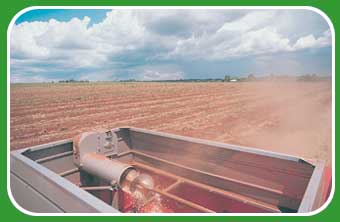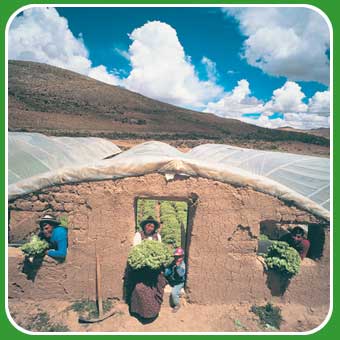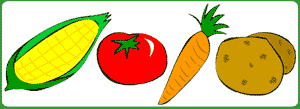| � |
Today, more food is being
produced than ever before, increasing more quickly than the
growth in the world's population. But there are over 800 million
people who do not have enough to eat.
"There can be no peace until people
have enough to eat � hungry people are not peaceful people"
Jimmy Carter, US President 1976-1980.
Useful websites on food and farming:
The U.N.'s Food and Agriculture Organisation (FAO) for information,
data and news items: www.fao.org/
For specific FAO data on different crops, livestock, etc in
individual countries: http://apps.fao.org/page/collections?subset=agriculture
Food and Farming partnership:
www.foodandfarming.org.uk
The Hunger Project (looking at sustainable ways to end hunger
with individual pages on different regions): www.thp.org/
The World Food Summit: www.fao.org/wfs/homepage.htm
Make YOUR contribution to help the
hungry by visiting www.thehungersite.com.
Every time you click on the screen, the website's sponsors
will donate food on your behalf.
Last year, there were 95,604,534 donations.
The website also links to other sites which help people living
with HIV/AIDS, victims of landmines and to save forests.

Success at a price

� Bruce Paton/Panos Pictures.
|
Using
modern technology to grow white beans in Zimbabwe. |
Globally, food production
has undergone a transformation in the last 50 years. With
greater mechanisation, improved irrigation, the use of chemicals
and the discovery of new plant breeding techniques, the amount
of food per person available has increased by 15%. But modern
farming methods have placed the natural environment under
enormous stress, and food shortages remain a problem in many
areas.
Shortages in times of plenty
 Click
on the globe to see a world map to show areas with severe
food shortages. Click
on the globe to see a world map to show areas with severe
food shortages.
Food shortages are rarely a result of one single cause.
In 2001, armed conflicts and three years of drought have left
seven million people in sub-Saharan Africa facing starvation.
People also go hungry in countries that enjoy food surpluses.
In India, 250 million people are malnourished
or hungry yet the country's granaries are full. But if the
poor don't have enough money to buy food, increased production
is not going to help them. Instead, the problem frequently
lies in food distribution and the poverty that prevents people
from earning enough to buy the food they need.
 for a spreadsheet of data on countries
with food shortages.
for a spreadsheet of data on countries
with food shortages.
 for help on how to use the spreadsheet (this will open a word
document which you can save or print)
for help on how to use the spreadsheet (this will open a word
document which you can save or print)
Use the spreadsheet data to answer these questions:
1. What is the relationship
(or "correlation") between:
a) GNP
per capita and daily calorie intake per capita?
b) Daily calorie
intake per capita and infant
mortality?
c) Daily calorie
intake per capita and food aid in cereals?
2. Which country appears
to be the odd one out when you compare daily calorie intake
per capita and food aid in cereals? Why do you think this
is?
3. What other data
not included on the spreadsheet might help you get a clearer
picture of why there are food shortages in some areas?
The Struggle for Small
Farmers
 �
Ron Giling/Still Pictures.
�
Ron Giling/Still Pictures. |
Small
farmers like these Aymara Indians in the Bolivian Andes
make up the majority of the developing world's food producers.
Farming families with landholdings of up to one hectare
are usually amongst the poorest and least nourished. Unlike
large landowners, small farmers cannot afford to buy fertilisers
in bulk, invest in modern irrigation systems, or hold
out for the best price for their crops.
Technology that could help them may not be accessible
either. Many small farmers are women. They produce 60-80%
of the food in the developing world, yet women are often
denied the right to own land at all.
|
A Millennium free
of Hunger?
The 21st century promises even more changes in the way we
produce food. The scientific techniques that use living organisms
to make or modify a product or improve plants or animals collectively
called, 'biotechnology' may lead to a very different future
in food production. But hi-tech solutions alone are unlikely
to eliminate food shortages. There is also a need to tackle
the underlying poverty that leads to hunger in the first place.
Go to the case study on the Gene Revolution
to find out more about the role of biotechnology in improving
food production.
The Evergreen Revolution
A growing number of people believe that the answer lies in
'sustainable agriculture'. This can take many forms depending
on local conditions and people's needs, but it is particularly
suitable for small farmers who cannot afford to take risks
and have to use their land efficiently as a matter of survival.
Building on farmers' existing knowledge and priorities, sustainable
farming projects use cheap, easily available technology to
boost harvests in ways that give farmers more self-reliance
and stability, and conserve their natural resources. Click
on the icon below to see some sustainable forms of farming:

Already, nine million
farmers in fifty developing countries have adopted sustainable
farming techniques. Some farmers have experienced 150% improvements
in their harvests, but sustainable agriculture is unlikely
to lead to massive leaps in farm productivity everywhere.
Nevertheless, by mixing modern science with traditional knowledge,
sustainable agriculture could help to meet the long-term food
needs of people without damaging the natural environment.
|
� |





